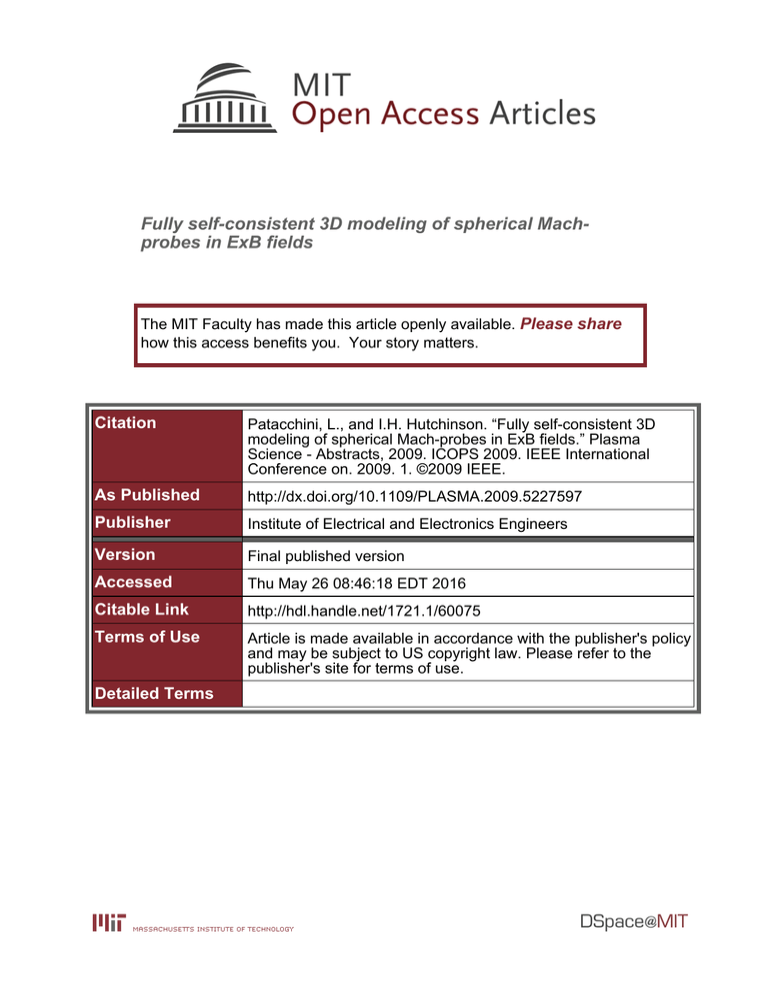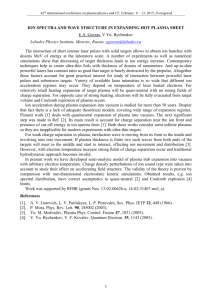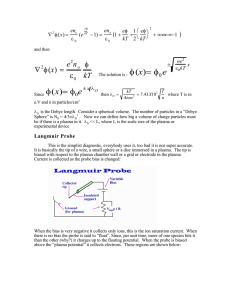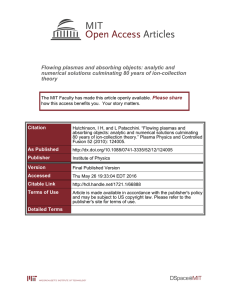Fully self-consistent 3D modeling of spherical Mach- probes in ExB fields
advertisement

Fully self-consistent 3D modeling of spherical Machprobes in ExB fields The MIT Faculty has made this article openly available. Please share how this access benefits you. Your story matters. Citation Patacchini, L., and I.H. Hutchinson. “Fully self-consistent 3D modeling of spherical Mach-probes in ExB fields.” Plasma Science - Abstracts, 2009. ICOPS 2009. IEEE International Conference on. 2009. 1. ©2009 IEEE. As Published http://dx.doi.org/10.1109/PLASMA.2009.5227597 Publisher Institute of Electrical and Electronics Engineers Version Final published version Accessed Thu May 26 08:46:18 EDT 2016 Citable Link http://hdl.handle.net/1721.1/60075 Terms of Use Article is made available in accordance with the publisher's policy and may be subject to US copyright law. Please refer to the publisher's site for terms of use. Detailed Terms FULLY SELF-CONSISTENT 3D MODELING OF SPHERICAL MACH-PROBES IN ExB FIELDS* L. Patacchini and I. H. Hutchinson Plasma Science and Fusion Center, MIT Cambridge, MA 02139, USA We carry out 3D particle-in-cell simulations accounting for the full ion distribution function, Boltzmann electrons, and the self-consistent potential profiles in the neighborhood of a sphere in a flowing magnetized plasma. This can be considered as the "spherical Mach-probe" problem, establishing how the ion flux to the surface varies with orientation, and with parallel and perpendicular external velocity. This dependence is required to interpret reliably experimental measurements on several tokamaks. We use our code SCEPTIC3D, a recent evolution of the particle-in-cell code SCEPTIC1,2, which includes arbitrary uniform magnetic field, external velocity magnitude and direction, ion temperature and electron Debye length. We compare our results in the strong-field regime with the analytic model which uses an isothermal fluid approximation, within the quasineutral (infinitesimal Debye length) and small Larmor radius limits3. Results show that for strongly magnetized plasmas the assumption of isothermal ions gives accurate flux, but can not be justified as the ion Larmor radius becomes finite. We then proceed with an in-depth analysis of how the widely adopted Mach-probe calibration formulas for infinitesimal Debye length, derived from fluid treatments such as Ref.3, are affected by non-zero Larmor radius effects. Accounting for finite Debye length changes the potential profiles around the sphere. In particular for conducting probes, a dipole-like field oriented parallel to the convective electric field appears, drastically changing the ion flow in the immediate vicinity of the probe, hence the collected flux. 1. I. H. Hutchinson, “Ion collection by a sphere in a flowing plasma: I. Quasineutral”, Plasma Phys. Control. Fusion 44, 1953-1977 (2002). 2. L. Patacchini and I. H. Hutchinson, “Angular distribution of current to a sphere in a flowing, weakly magnetized plasma with negligible Debye length”, Plasma Phys. Control. Fusion 49, 1193-1208 (2007). 3. I. H. Hutchinson, “Oblique ion collection in the driftapproximation: how magnetized Mach-probes really work”, Physics of Plasmas 15, 123503 (2008). ________________________________ * Leonardo Patacchini was supported in part by the NSF/DOE Grant No DE-FG-06ER54891. The SCEPTIC3D calculations were performed on the Alcator cluster Unity and the PSFC cluster Loki. 978-1-4244-2636-2/09/$25.00 ©2009 IEEE







